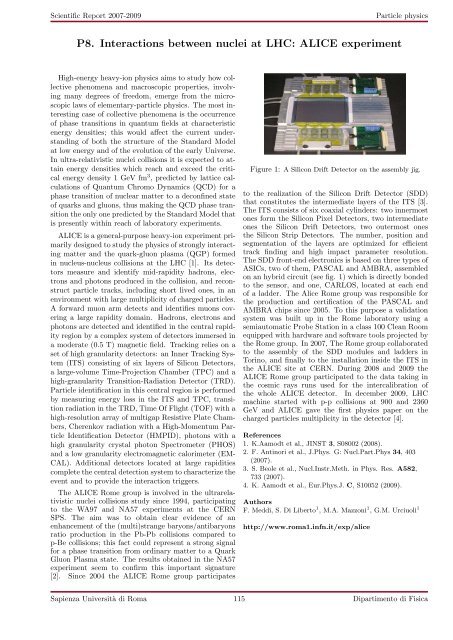download report - Sapienza
download report - Sapienza
download report - Sapienza
Create successful ePaper yourself
Turn your PDF publications into a flip-book with our unique Google optimized e-Paper software.
Scientific Report 2007-2009<br />
Particle physics<br />
P8. Interactions between nuclei at LHC: ALICE experiment<br />
High-energy heavy-ion physics aims to study how collective<br />
phenomena and macroscopic properties, involving<br />
many degrees of freedom, emerge from the microscopic<br />
laws of elementary-particle physics. The most interesting<br />
case of collective phenomena is the occurrence<br />
of phase transitions in quantum fields at characteristic<br />
energy densities; this would affect the current understanding<br />
of both the structure of the Standard Model<br />
at low energy and of the evolution of the early Universe.<br />
In ultra-relativistic nuclei collisions it is expected to attain<br />
energy densities which reach and exceed the critical<br />
energy density 1 GeV fm 3 , predicted by lattice calculations<br />
of Quantum Chromo Dynamics (QCD) for a<br />
phase transition of nuclear matter to a deconfined state<br />
of quarks and gluons, thus making the QCD phase transition<br />
the only one predicted by the Standard Model that<br />
is presently within reach of laboratory experiments.<br />
ALICE is a general-purpose heavy-ion experiment primarily<br />
designed to study the physics of strongly interacting<br />
matter and the quark-gluon plasma (QGP) formed<br />
in nucleus-nucleus collisions at the LHC [1]. Its detectors<br />
measure and identify mid-rapidity hadrons, electrons<br />
and photons produced in the collision, and reconstruct<br />
particle tracks, including short lived ones, in an<br />
environment with large multiplicity of charged particles.<br />
A forward muon arm detects and identifies muons covering<br />
a large rapidity domain. Hadrons, electrons and<br />
photons are detected and identified in the central rapidity<br />
region by a complex system of detectors immersed in<br />
a moderate (0.5 T) magnetic field. Tracking relies on a<br />
set of high granularity detectors: an Inner Tracking System<br />
(ITS) consisting of six layers of Silicon Detectors,<br />
a large-volume Time-Projection Chamber (TPC) and a<br />
high-granularity Transition-Radiation Detector (TRD).<br />
Particle identification in this central region is performed<br />
by measuring energy loss in the ITS and TPC, transition<br />
radiation in the TRD, Time Of Flight (TOF) with a<br />
high-resolution array of multigap Resistive Plate Chambers,<br />
Cherenkov radiation with a High-Momentum Particle<br />
Identification Detector (HMPID), photons with a<br />
high granularity crystal photon Spectrometer (PHOS)<br />
and a low granularity electromagnetic calorimeter (EM-<br />
CAL). Additional detectors located at large rapidities<br />
complete the central detection system to characterize the<br />
event and to provide the interaction triggers.<br />
The ALICE Rome group is involved in the ultrarelativistic<br />
nuclei collisions study since 1994, participating<br />
to the WA97 and NA57 experiments at the CERN<br />
SPS. The aim was to obtain clear evidence of an<br />
enhancement of the (multi)strange baryons/antibaryons<br />
ratio production in the Pb-Pb collisions compared to<br />
p-Be collisions; this fact could represent a strong signal<br />
for a phase transition from ordinary matter to a Quark<br />
Gluon Plasma state. The results obtained in the NA57<br />
experiment seem to confirm this important signature<br />
[2]. Since 2004 the ALICE Rome group participates<br />
Figure 1: A Silicon Drift Detector on the assembly jig.<br />
to the realization of the Silicon Drift Detector (SDD)<br />
that constitutes the intermediate layers of the ITS [3].<br />
The ITS consists of six coaxial cylinders: two innermost<br />
ones form the Silicon Pixel Detectors, two intermediate<br />
ones the Silicon Drift Detectors, two outermost ones<br />
the Silicon Strip Detectors. The number, position and<br />
segmentation of the layers are optimized for efficient<br />
track finding and high impact parameter resolution.<br />
The SDD front-end electronics is based on three types of<br />
ASICs, two of them, PASCAL and AMBRA, assembled<br />
on an hybrid circuit (see fig. 1) which is directly bonded<br />
to the sensor, and one, CARLOS, located at each end<br />
of a ladder. The Alice Rome group was responsible for<br />
the production and certification of the PASCAL and<br />
AMBRA chips since 2005. To this purpose a validation<br />
system was built up in the Rome laboratory using a<br />
semiautomatic Probe Station in a class 100 Clean Room<br />
equipped with hardware and software tools projected by<br />
the Rome group. In 2007, The Rome group collaborated<br />
to the assembly of the SDD modules and ladders in<br />
Torino, and finally to the installation inside the ITS in<br />
the ALICE site at CERN. During 2008 and 2009 the<br />
ALICE Rome group participated to the data taking in<br />
the cosmic rays runs used for the intercalibration of<br />
the whole ALICE detector. In december 2009, LHC<br />
machine started with p-p collisions at 900 and 2360<br />
GeV and ALICE gave the first physics paper on the<br />
charged particles multiplicity in the detector [4].<br />
References<br />
1. K.Aamodt et al., JINST 3, S08002 (2008).<br />
2. F. Antinori et al., J.Phys. G: Nucl.Part.Phys 34, 403<br />
(2007).<br />
3. S. Beole et al., Nucl.Instr.Meth. in Phys. Res. A582,<br />
733 (2007).<br />
4. K. Aamodt et al., Eur.Phys.J. C, S10052 (2009).<br />
Authors<br />
F. Meddi, S. Di Liberto 1 , M.A. Mazzoni 1 , G.M. Urciuoli 1<br />
http://www.roma1.infn.it/exp/alice<br />
<strong>Sapienza</strong> Università di Roma 115 Dipartimento di Fisica

















